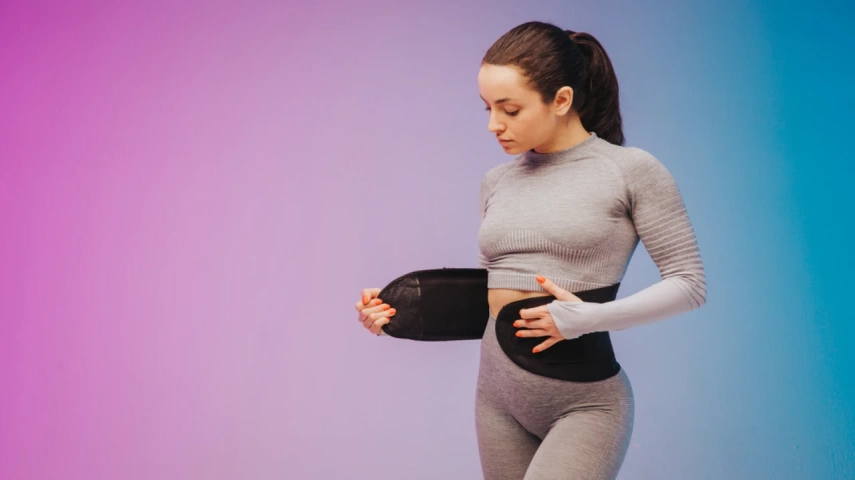A Comprehensive Answer to the Question - Do Waist Trainers Work?
Waist trainers are popular and have been used for a long time. But questions regarding its efficacy persist and the query - do waist trainers work - is valid.

Waist trainers have been a popular presence within the fitness and the fashion industry for quite some times now. However, the question, do waist trainers work, have persisted throughout. In today’s age of appearances and social media bombarding images of physical perfection, we are more attuned towards achieving the ideal physician state. In this quest we may often make decisions that could prove to be counterproductive in the long run. So if you have wondered, do waist trainers actually work, or are curious about its role and efficiency, read on.
What is a Waist Trainer?
Waist trainers are sleek, form-fitting garments that have captivated the attention of many, promising a cinched waistline and a confidence boost. They are typically made of materials like latex or other sturdy fabrics and are worn tightly around the midsection. The idea behind waist trainers is that they provide compression and support to the waist area, which some people believe can lead to a slimmer waistline with prolonged use.
Advocates of waist trainers extol their virtues with promises of a sculpted waistline, improved posture, and enhanced self-confidence. Some manufacturers even suggest that waist trainers can aid in weight loss by increasing thermal activity and stimulating perspiration around the waist area.
While the prospect of achieving a smaller waist may be enticing, it is vital to recognize the potential risks associated with waist trainers. Medical professionals and fitness experts caution that prolonged and excessive use of waist trainers can lead to adverse health effects. These may include restricted breathing, decreased core muscle strength, organ compression, and even skeletal rearrangement.
Furthermore, the surge in popularity of waist trainers has sparked a heated debate among health professionals, fitness enthusiasts, and consumers. Critics argue that relying on external means to alter body shape is unrealistic and can perpetuate unrealistic beauty standards. They advocate for embracing body diversity and promoting a healthy body image instead.
It's important to note, however, that the effectiveness and safety of waist trainers are subjects of debate, and it's always advisable to consult with a healthcare professional before using any kind of restrictive garment.
How Do Waist Trainers Work?
Let us now look at what waist trainers do actually.
- Compression And Support: At the core of waist trainers' functionality lies the concept of compression. These specially designed garments are constructed using materials like latex or compression fabrics that provide a firm, yet flexible, hold around the midsection. The compression helps to shape and contour the waistline, creating a more defined and cinched appearance.
- Posture Support: Waist trainers not only shape the waistline but also provide support for proper posture. The firm compression encourages individuals to maintain an upright position, aligning the spine and minimizing slouching. By improving posture, waist trainers can alleviate back pain and promote better overall body alignment.
- Core Muscle Engagement: Wearing a waist trainer can also engage and activate the core muscles. The compression around the midsection prompts individuals to be more conscious of their core and abdominal muscles, as they must work against the resistance provided by the garment. This engagement can help strengthen and tone the core muscles over time, leading to improved muscle definition and stability.
- Thermal Activity And Perspiration: Some waist trainers boast an additional feature—the promotion of thermal activity and increased perspiration. The tight compression around the waist generates heat, which can potentially raise the body's temperature in that area. This increase in temperature is believed to stimulate perspiration and, in turn, aid in detoxification and water weight loss (1).
- Instant Figure Enhancement: One of the immediate effects of wearing a waist trainer is the visual transformation it offers. The compression around the waist creates an instant slimming effect, making the waistline appear smaller and more defined. This instant figure enhancement can provide individuals with a boost in confidence and an overall sense of satisfaction with their appearance.
- Appetite Suppression: Some individuals report experiencing appetite suppression while wearing waist trainers. The compression around the midsection can create a feeling of fullness and reduce the capacity of the stomach to expand (2). As a result, individuals may consume smaller portions during meals, aiding in portion control and potentially contributing to weight management.
- Supplementary Fitness Aid: Waist trainers are often seen as a supplementary aid to regular exercise and a balanced diet. They are not intended as a substitute for healthy lifestyle habits but can complement existing efforts. By providing support and compression to the midsection, waist trainers can help individuals maintain proper form during workouts, engage the core muscles, and maximize the benefits of physical activity.
- Improved Body Awareness: By wearing a waist trainer, individuals can develop a greater sense of body awareness. The compression around the waist area prompts individuals to be more conscious of their posture, movements, and overall body alignment. This increased awareness can translate into better body mechanics and a more mindful approach to physical activities.
- Motivational Tool: For many, waist trainers serve as a motivational tool in their fitness journey. The visual and physical changes that occur when wearing a waist trainer can boost individuals' motivation and drive to achieve their goals. This increased motivation may translate into a more dedicated approach to exercise and healthy eating habits.
Benefits of a Waist Trainer
Now that we have looked at what a waist trainer does, let us look at some of the benefits of a waist trainer.
Waistline Transformation:
One of the most alluring aspects of waist trainers is their ability to provide an immediate transformation of the waistline. These garments feature a firm compression mechanism that cinches the midsection, creating a visually smaller and more defined waist. The instant figure enhancement offered by waist trainers can boost confidence and leave individuals feeling more satisfied with their appearance.
Enhanced Hourglass Silhouette:
By effectively redistributing and reshaping the waistline, waist trainers accentuate the natural curves of the body, creating an enhanced hourglass silhouette. The compression helps to slim down the waist while emphasizing the curves of the hips and bust, resulting in a more proportionate and aesthetically pleasing figure.
Posture Support And Spinal Alignment:
Waist trainers not only shape the waistline but also provide support for proper posture. The firm compression around the midsection encourages individuals to maintain an upright position, aligning the spine and minimizing slouching. This improved posture can alleviate back pain, reduce strain on the back muscles, and contribute to better overall body alignment.
Core Muscle Activation And Toning:
Wearing a waist trainer can engage and activate the core muscles. The compression around the midsection prompts individuals to be more conscious of their core and abdominal muscles, as they work against the resistance provided by the garment. This engagement can help strengthen and tone the core muscles over time, leading to improved muscle definition, stability, and overall core strength (3).
Motivational Tool for Fitness:
For many individuals, waist trainers serve as a motivational tool in their fitness journey. The visible and physical changes that occur when wearing a waist trainer can boost motivation and drive to achieve fitness goals. The continuous use of a waist trainer during workouts can enhance focus, encourage proper form, and create a heightened awareness of the core muscles. This heightened motivation and engagement may contribute to a more dedicated approach to exercise and an overall improvement in fitness levels.
Confidence Boost:
Waist trainers have the potential to significantly boost confidence levels. By providing a slimmer waistline and enhanced curves, these garments allow individuals to feel more comfortable and confident in their bodies. The improved body image can have a positive impact on self-esteem, self-image, and overall mental well-being.
Postpartum Support And Recovery:
Waist trainers can also play a role in postpartum support and recovery. After childbirth, the abdominal muscles may be weakened, and the abdominal area may appear distended. Waist trainers can provide gentle compression and support to the abdominal region, aiding in muscle recovery and providing a sense of stability. However, it is crucial to consult with a healthcare professional before using a waist trainer postpartum to ensure proper healing and suitability for individual circumstances.
Increased Sweating And Detoxification:
Certain waist trainers are designed to promote thermal activity and increase sweating in the waist area. The heat generated by the compression can stimulate perspiration, potentially aiding in detoxification and eliminating water weight. However, it is essential to stay adequately hydrated and avoid excessive or prolonged use, as excessive sweating can lead to dehydration.
Fashionable And Versatile:
Apart from their functional benefits, waist trainers have gained popularity as fashionable and versatile garments. They come in various styles, colors, and designs, allowing individuals to choose options that suit their personal taste and style. Waist trainers can be incorporated into everyday outfits or even worn as a fashion statement, providing an added touch of confidence and style.
Side Effects of Waist Trainers
Waist trainers have gained considerable popularity as a tool for achieving a desirable figure, but it is crucial to understand that their usage comes with potential side effects and risks. While waist trainers can provide temporary enhancements and immediate visual changes, it is essential to weigh the potential drawbacks. In this informative blog, we explore the side effects of waist trainers, shedding light on the potential risks associated with their usage.
Restricted Breathing And Discomfort:
One of the most common side effects of waist trainers is restricted breathing. The tight compression around the midsection can limit the expansion of the diaphragm and hinder proper breathing patterns. This restriction can lead to discomfort, shortness of breath, and reduced lung capacity. Prolonged use of waist trainers can exacerbate these issues and affect overall respiratory function.
Digestive Problems:
Waist trainers can exert pressure on the stomach and other digestive organs, potentially leading to digestive problems. The compression can cause acid reflux, heartburn, and difficulty in digesting food. The reduced space in the abdominal area can also hinder the normal movement of the intestines, leading to constipation and bloating.
Muscle Weakness And Atrophy:
Continuous reliance on waist trainers for abdominal support can weaken the core muscles over time. The constant external support provided by the garment can cause the muscles to become dependent, leading to muscle atrophy and reduced muscle tone. This can ultimately result in a loss of core strength and stability.
Skin Irritation And Sensitivity:
The materials used in waist trainers, particularly those made from synthetic fabrics, can cause skin irritation and sensitivity. The tight compression combined with friction against the skin can lead to redness, chafing, and discomfort. Individuals with sensitive skin or pre-existing skin conditions may be more prone to these issues.
Organ Compression:
Extended use of waist trainers can potentially compress internal organs, including the liver, spleen, and kidneys. Prolonged compression can impede the normal functioning and circulation of these organs, potentially leading to organ damage or dysfunction. It is especially important to be cautious and avoid excessive or prolonged use, as it can increase the risk of these adverse effects.
Decreased Core Strength And Stability:
Relying solely on waist trainers for core support can lead to a decline in natural core strength and stability. The compression provided by the garment may give a false sense of stability, masking underlying weakness in the core muscles. Over time, this can result in decreased functional strength and stability, making individuals more susceptible to injuries and postural imbalances.
Psychological Dependence And Body Image Concerns:
Extended usage of waist trainers can lead to psychological dependence and body image concerns. Reliance on a garment to achieve a desired appearance may negatively impact self-esteem and body image perception. It is essential to maintain a balanced perspective and prioritize overall well-being over external appearance.
Conclusion:
The waist trainer trend, with all its allure and controversy, continues to capture the attention of many seeking a shortcut to an ideal figure. The answer to do waist trainers work is nuanced. While waist trainers may offer temporary cosmetic benefits, their long-term effects and safety concerns cannot be ignored. It is imperative to approach these garments with caution and prioritize one's overall health and well-being above fleeting trends. Clean eating and regular exercises are a must if you desire a fit state of being. Instead of fixating on unrealistic beauty standards, let us celebrate body diversity and embrace the uniqueness that lies within each of us.
Sources:
1. Physiology of sweat gland function: The roles of sweating and sweat composition in human health
https://www.ncbi.nlm.nih.gov/pmc/articles/PMC6773238/
2. Magnetic Resonance Imaging of Cerebrospinal Fluid Volume and the Influence of Body Habitus and Abdominal Pressure
3. Diaphragmatic Breathing The Foundation of Core Stability
https://journals.lww.com/nsca-scj/Fulltext/2012/10000/Article.5.aspx





 JOIN OUR WHATSAPP CHANNEL
JOIN OUR WHATSAPP CHANNEL
































































































